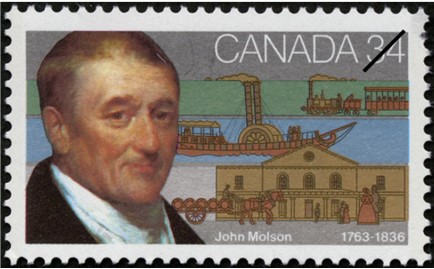John Molson National Historic Person (1763-1836)

© Library and Archives Canada; Canada Post Corporation, Stamp Services
John Molson (1763-1836) was designated a national historic person in April 2021.
John Molson was one of Montréal's leading entrepreneurs in the late 18th and early 19th centuries. By leading the construction of the first steamboat (1809) and the first railroad (1836) in British North America, he contributed to the early phase of the transportation revolution in the colonies of Lower and Upper Canada in the first third of the 19th century. These technologies proved central to the economic progress of these colonies. Molson also facilitated the transition to mechanized industry in Lower Canada by introducing steam-powered machinery in his businesses. Finally, during the important period when Montréal matured from a small colonial town into the commercial and financial metropolis of the Canadas, Molson contributed to the development of Montréal's leading institutions, such as the Bank of Montreal and the Montreal General Hospital.
Building the Molson Brewery
John Molson was born in England and settled in Montréal after immigrating in 1782. One year after his arrival, he joined in a brewing enterprise, then in 1785 became its sole owner. Over the next 20 years, Molson expanded the company, increased production, and made it one of the largest breweries in the colony. Molson Brewery's success allowed its owner to diversify his activities.
Diversifying his activities
Beginning in 1809, Molson financed the construction of several steamboats, including the Accommodation, the first steamship to make a commercial voyage in British North America. In 1822, he established a steamboat company on the St. Lawrence River called the St. Lawrence Steamboat Company, then in the 1830s, he was the principal shareholder of Canada's first railway, the Champlain and Saint Lawrence Railroad. Molson also owned hotels and the city's first performing arts venue, the Theatre Royal, invested in real estate, and built wharves for his steamships in Montréal, Sorel, and Québec City. In 1822, Molson acquired several shares in the Bank of Montreal before being elected to its board of directors two years later. In 1826, he became the bank's president, a position he held for four years. On the political front, Molson was a member of the Lower Canada House of Assembly for the riding of Montréal East from 1816-20 and was heavily involved in building the Lachine Canal, then from 1830-35, he served on the Legislative Council of Lower Canada.
Introduction of steam engine in the Molson Brewery
Molson's efforts to build steam engines for his ships laid the foundation for later developments in the industrial sector. As the owner of St. Mary's Foundry, Molson began supplying Canadian steam engines to the shipbuilding industry in the 1810s. St. Mary's Foundry eventually began producing stationary engines, mill turbines, and other machinery for the local market. By 1811, the introduction of a steam engine to pump water and grind malt was the first step in Molson Brewery's transition from craft-based to industrial production. Although the mechanization of production evolved slowly during his lifetime, Molson's work proved decisive for the emergence of industrial production in Montréal in the following decades.
A community leader
Molson used his wealth and influence for philanthropic activities. In 1819, he and his three sons joined a group of Montréalers who financed the creation of a private hospital, the Montreal General Hospital. Molson served as the hospital's vice-president from its official founding and as president from 1831-35. In addition, he financially supported the Unitarian Congregation of Montréal in the last years of his life. Shortly before his death in Boucherville on 11 January 1836, Molson dictated the provisions of his will in such a way that would ensure the business would continue to be family run.
The National Program of Historical Commemoration relies on the participation of Canadians in the identification of places, events and persons of national historic significance. Any member of the public can nominate a topic for consideration by the Historic Sites and Monuments Board of Canada.
- Date modified :